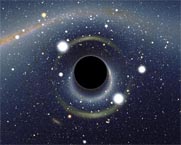New proof of giant black hole at galaxy's centre, German experts say
 Hamburg, Germany - A team of German scientists have come up with compelling, new proof that a huge, giant black hole of unimaginable dimensions is at the very heart and centre of our galaxy.
Hamburg, Germany - A team of German scientists have come up with compelling, new proof that a huge, giant black hole of unimaginable dimensions is at the very heart and centre of our galaxy.
For decades, astronomers have speculated about the possibility of a black hole at the Milky Way galaxy's centre. But because of the billions of stars which lie between Earth and the hub of the galaxy, it has always been impossible to see what is actually at the centre.
Now the German researchers say they have established the existence of an enormous black hole at the centre "beyond any reasonable doubt".
The scientists at the Max-Planck Institute for Extraterrestrial Physics in Garching, near Munich, conducted 16 years of studies on 28 stars circling the centre of the Milky Way. By studying the movements of these stars, the scientists say they were able to determine the characteristics of the object around which they are circling.
"Undoubtedly the most spectacular aspect of our long term study is that it has delivered what is now considered to be the best empirical evidence that super-massive black holes do really exist," said Max Planck study leader Professor Reinhard Genzel.
"The stellar orbits in the galactic centre show that the central mass concentration of four million solar masses must be a black hole, beyond any reasonable doubt."
The astronomers were also able to measure with great accuracy how far the Earth is from the centre of the galaxy - a distance of 27,000 light years.
To overcome the age-old problem of penetrating the stellar dust and glare from billions of stars between Earth and the centre of the galaxy, the German astronomers focused on infrared light wavelengths that can penetrate the dust clouds.
The galaxy's central mass, long suspected of being a giant black hole, is known as "Sagittarius A star."
The European Southern Observatory study, which began in 1992, was made using the 3.5 metre New Technology Telescope at the La Silla observatory and the Very Large Telescope - an array of four 8.2 metre telescopes at the Paranal observatory. Both operate from the Atacama desert in Chile.
The research is published in the Astrophysical Journal. (dpa)